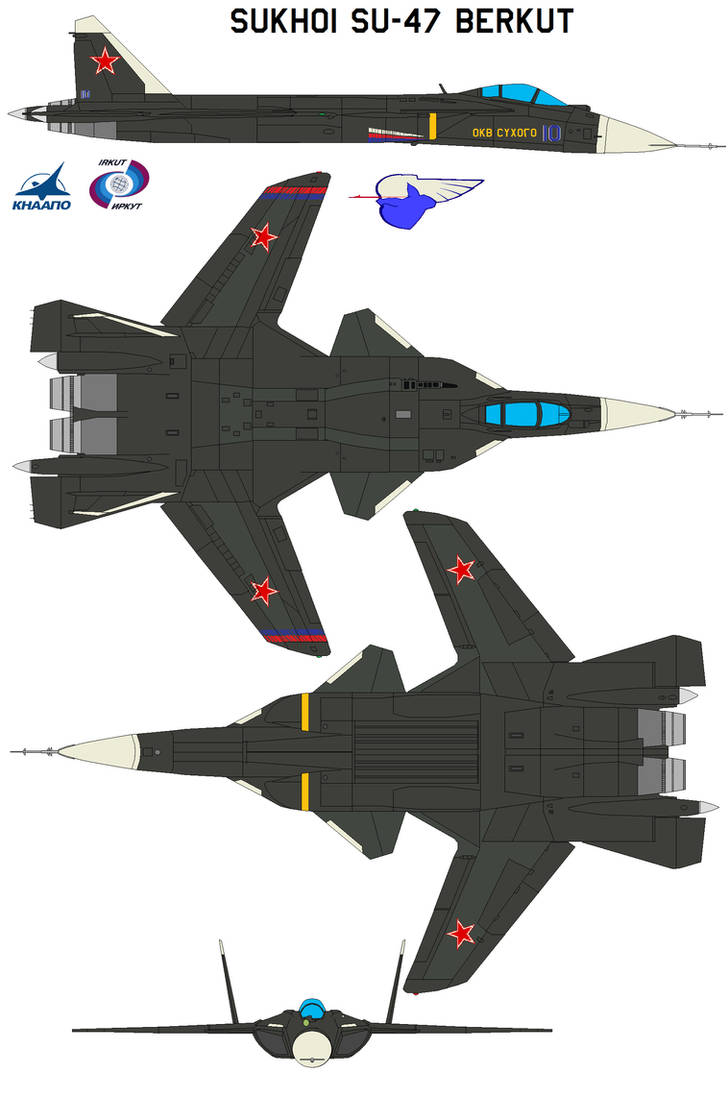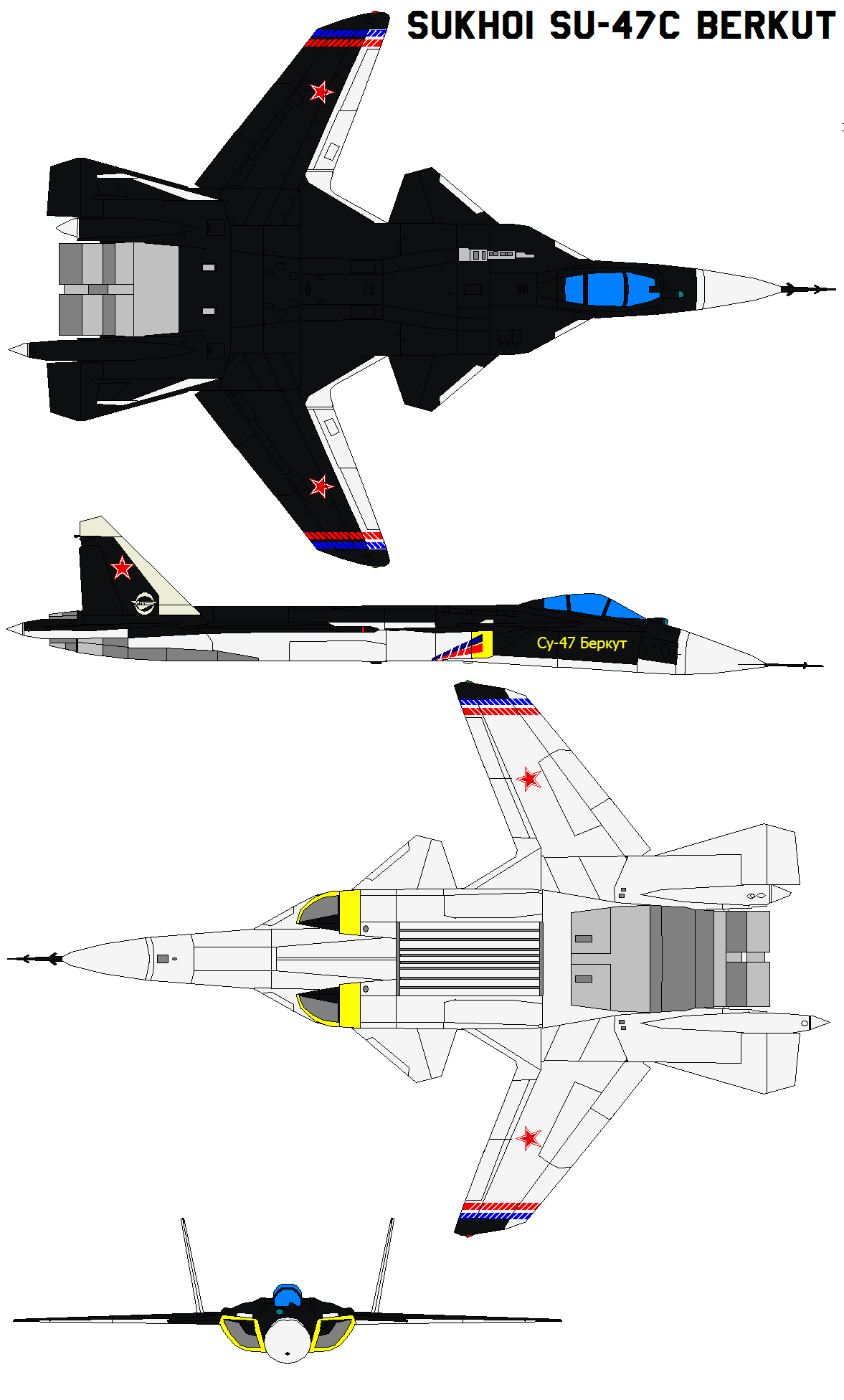Berkut Aircraft - This article is about the aircraft once designated the S-37. For the aircraft designated Su-37, see Sukhoi Su-37.
This article requires additional citations for verification. Please help make this article better by adding citations to specific sources. Unsourced content can be challenged and removed. I found sources: "Sukhoi Su-47" - News · Journals · Books · Scholar · JSTOR (July 2009) (Learn how and why to remove this template message)
Berkut Aircraft

Proposed by Sukhoi in the early 1990s (nicknamed Su-37) during initial development, the JSC was an experimental supersonic fighter developed by the Sukhoi Company. His own wing was a forward sweeper
Renaissance Composites Berkut · The Encyclopedia Of Aircraft David C
Which gave the aircraft excellent agility and maneuverability. Serial production of this type never materialized and configuration was never advanced, only aircraft produced served as a technology demonstrator prototype for some advanced technology in the later 4.5 generation fighter Su-35 and current fifth generation jet fighter Su. -57.
Originally known as the S-37, Sukhoi retired its advanced testing in 2002 as the Su-47. Officially nicknamed the Berkut (Russian: Беркут) (Russian for golden eagle), the Su-47 was originally built as Russia's flagship aircraft. Tested for composite materials and a sophisticated fly-by-wire control system, as well as new airframe technology.
TsAGI has long been aware of the advantages of front wings, with research including the development of the Tsibin LL and the study of the captured Junker Ju 287 in the 1940s. At sharp angles of attack, the rear wing tips remain to allow the aircraft to maintain aileron control. In contrast to more conventional swept wings, the forward sweep creates a geometrically greater angle of incidence of the outer wing sections where the wing is under load. Bding wings experience high torques, which cause the wing to fail structurally at lower speeds than straight or trailing wings.
The project was launched in 1983 at the behest of the Soviet Air Force. However, when the Soviet Union was dissolved, the financial support stopped and the development continued only with the financial support of Sukhoi.
Former Raf F 22 Raptor Pilot Wants Augmented Reality To Change The Way Us Aviators Train
Like the American Grumman X-29, the Su-47 is primarily a technical demonstrator for future Russian fighters such as the Sukhoi Su-57. A forward swept wing configuration was ultimately not achieved because it was primarily useful at transonic speeds while a swept wing excelled at supersonic speeds.
The Su-47 has the same dimensions as Sukhoi's previous large fighter jet, the Su-35. The Su-47 borrowed the front fuselage, vertical tail and landing gear of the Su-27 family to reduce development costs. However, the aircraft includes an internal weapons bay and an advanced partitioned space.
Like its closest predecessor, the Su-37, the Su-47 has a three-point extension, with canards in front of the wings and tailplanes. The Su-47 has two tailbooms of unequal lgth exhaust nozzles. The short boom, on the left, tames the ecM system, while the long boom rubs the roofs.

The Su-47 has extremely high agility at subsonic speeds, which enables the aircraft to change the angle of attack and its flight path very quickly, while maintaining maneuverability in supersonic flight. The Su-47 has a maximum speed of Mach 1.6 at high altitude and a 9g capability.
Aircraft N67xp (2005 Berkut 540 C/n 035) Photo By Clayton Eddy (photo Id: Ac1514762)
The curved mid-shaft gives the Su-47 its sleek appearance. A substantial part of the lift generated by the front wing was pulled inside the wing. This inboard lift is not restricted by the wing tip arm and the generation of lifted vortices induced by the wing is thus reduced. Horn control surfaces - remain effective at very high angles of attack, and control of the aircraft is maintained in the event of air-flow over the rest of the wing surface.
The deflection of such a forward wing design is to produce a geometrically twisted wing to bds under load, resulting in greater wing strength than a similar straight or rearward wing. This requires the pen design to twist bds, as opposed to geometric twist. This is done by using a wing made of leather to twist. The aircraft was initially limited to Mach 1.6. Because forward sweep was most useful at transonic speeds, while aft wing sweep was lost at supersonic speeds, it was not pursued further.
Send vectoring of ±20° to 30°/s in pitch and yaw (with PFU gene modification) greatly supports the agility achieved by other aspects of the design.
The Northrop N-9M (United States) and the Hort Ho 229 (Nazi Germany) are the world's first propeller-driven and jet-powered stealth-wing aircraft, respectively. This article is about US-made, propeller-driven propellers. Aviation developer It was built for the Russian, powerful experimental fighter called the Berkut, see the Sukhoi Su-47.
Russia Is Using Su 47 'berkut', The Fighter Jet With Reverse Sweep Wing Design, To Develop Combat Uavs
The Berkut 360 is a domestically built canard aircraft with a tandem-seated, flapper configuration and retractable landing gear, constructed primarily of carbon fiber and fiberglass.
The Berkut prototype was designed and built by Dave H. Ronneberg and Donald S. Ronneberg. As part of a business partnership between Murphy called Experimental Aviation, which ran from 1989 to 1992.
In 1992 the company dissolved and Ronneberg founded Experimental Aviation, Inc. Incorporated as, the aircraft are for sale as a kit, while Murphy wanted to stick with the project. A series of cases between the two resulted in Ronneberg and Murphy being separated from each other and the Experimental Aviation Corporation was dissolved. The kit was reborn in 1996 by Richard Riley and Risen, with Ronneberg serving as a consultant.

In January 2001, under Ronneberg's pressure, Resance was sold to American aerobatic pilot Vicky Kruse.
Sukhoi Su 47 Berkut: The Ussr's Strangest Aircraft
This company withdrew from the aircraft market in 2002. Ronneberg continued the project, which is now aimed at the UAV market.
A deal was reached in 2003 to sell the project to State Aerospace, but the deal fell through. Kruse was not involved in long-term operations, but retained ownership until his death on August 22, 2009, when the aircraft he was flying - a borrowed Zivko Edge 540 - crashed in Gland, Buckinghamshire. World Aerobatic Championships.
Derived from the Berkut Rutan Long-EZ, the primary differences are the retractable main access arms, the dual sags, and the fuselage, struts, and flared horns. Like the Long EZ, the Berkut carries two people in one seat arrangement. The front seat occupant has access to all instruments and controls. The rear seat, usually holding the passenger, is equipped with side sticks and a choke, but lacks pedals, cushions or instruments. Aerodynamic improvements were made to the original Long-ez airframe to improve performance and increase interior space. the fuselage was extended and the nose, canard, instrument panel and pilot were moved forward a foot (300 mm) to allow the use of a heavier pedicle at the rear. The trailing edge of the main wing was straightened, removing the small bd on the edge of the long ez wing mesh. The lower fin was removed and the aileron size increased in both chord and span, significantly increasing the roll rate.
Early Berkuts used wings and canards that were similar in structure to the Long-EZ and used solid blue 2 lb/cu. ft. dsity Dow STYROFOAM PI cores are cut to shape with a hot-wire flap, but carbon fiber reinforced for a fiberglass polymer skin. The fiberglass fuselage and wings remained. Later versions (kits after spring 1999) used canards and wings with higher density, 5 lb/cu, fully formed carbon fibers. ft. 1/4" thick PVC or SAN foam core leaving only small equalization and top surfaces to be carved out of the foam. Berkut has always used a canard airfoil on the Roncz 1145MS, which is more tolerant of insect and rain contamination than the GU 25. -5(11) 8 airfoils in the beginning used in Long-EZ.
Aircraft N73ez (2007 Berkut 360 C/n 0024) Photo By Doug Robertson (photo Id: Ac1080599)
Berkut used a retractable main (rear) exposing gear system designed by Shirl Dickey for his home-built E-Racer. At first, Berkut used gear parts produced by Dickey, but over time they were repeatedly redesigned and strengthened. Captions were introduced in later home kits. Like the earlier Vari-Eze and Long EZ, the Berkut had its nose gear bent to prevent the aircraft from pulling back when placed without a pilot in the first seat. Some old Berkuts used a hydraulic nose extension system, but most used electro-mechanical pharmacy screws. With the electric system, the pilot and passenger can climb into the cockpit, extend the nose gear, and lift the airplane with the passengers inside.
While the Long-EZ, originally designed for the Lycoming O-235 108-118 hp engine, was close in design to the Berkut, here it was designed from scratch for the larger Lycoming IO-360 180 hp engine. The aircraft was later modified with different trap racks, hoods and battery locations to the 260 hp Lycoming IO-540 selected by most manufacturers. With the O-540 some reached speeds of 300 mph in level flight.
For whatever reason, Berkut has a poor overall safety record, having built at least 31 aircraft that have been involved in serious accidents or crashes. The manufacturer or someone close to the manufacturer explained:

"In the first years there were some accidents due to errors in the church, so it was decided to finish it and start selling it (or with support in the final construction).
Russian Air Force Su 47 Berkut Fighter Jet Desktop Hd Wallpaper 2560x1600
Sukhoi su-47 berkut, berkut aircraft plans, berkut kit plane, berkut plane for sale, hotel berkut, berkut aircraft kit for sale, berkut, berkut aircraft for sale, su 47 berkut, zakhar berkut, su-47 berkut model, berkut 540 for sale
0 Comments